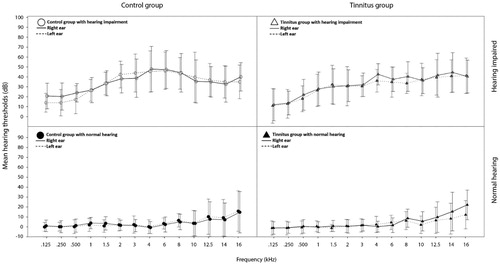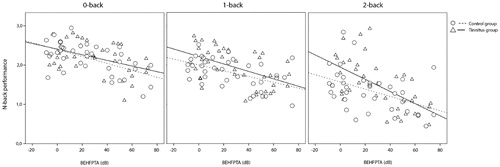Figures & data
Figure 1. Mean hearing thresholds at 0.125–16 kHz in left and right ear, for the normal hearing (n = 19) and the hearing impaired (n = 19) participants of the tinnitus group, and the normal hearing (n = 19) and the hearing impaired (n = 19) participants of the control group. Error bars = 1 SD.

Table 1. Demographic statistics for all participants and each group.
Table 2. Characteristics of participants with tinnitus (n = 38).
Figure 2. Relationship between high frequency hearing (best ear high frequency pure tone average at 10, 12.5, 14 and 16 kHz) and working memory (n-back performance) for each group and n-back condition. Lines depict the line of best fit for each group and n-back condition.

Table 3. Results of the multivariate MANCOVA analysis of all participants for the effect of tinnitus on working memory scores as measured by the performance on the n-back test (0-, 1- and 2-back conditions combined), corrected for anxiety, depression, BEPTA and BEHFPTA.
Table 4. Results of the univariate MANCOVA analyses of all participants for the effect of tinnitus on working memory scores as measured by the performance on each of the n-back tests separately (0-, 1- or 2-back conditions), corrected for anxiety, depression, BEPTA and BEHFPTA.
Table 5. Results of the multivariate multiple regression analysis predicting n-back performance in individuals with tinnitus based on THI, anxiety, depression, BEPTA and BEHFPTA.
